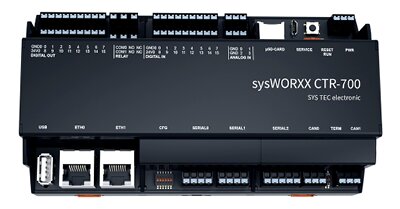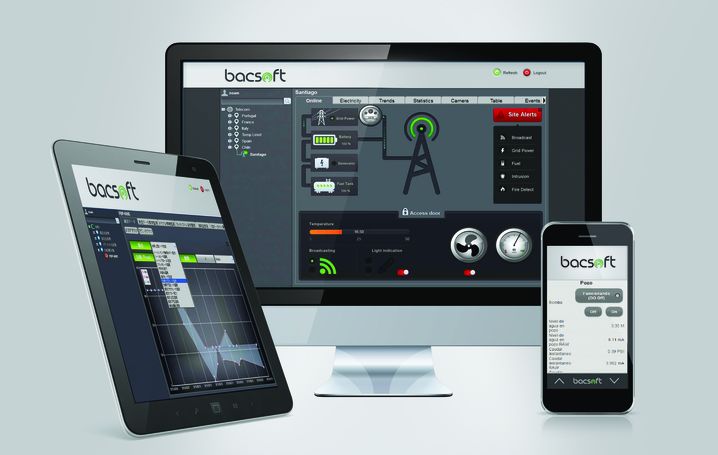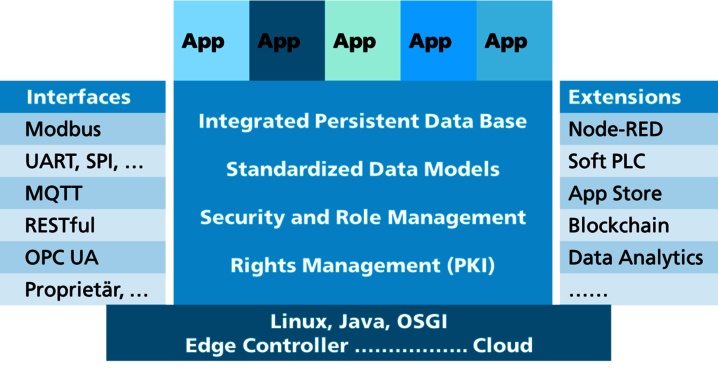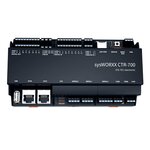Energy always in view
It wasn't so long ago that energy management was limited to manually switching devices on and off and occasionally opening the door for the meter reader. Nowadays, the use of energy is meticulously monitored and controlled in detail. Even far away from centralized power supply, energy management is playing an increasingly important role.
With increasing networking, comprehensive possibilities are opening up for the management and control of electrical energy. Integration into the Internet of Things (IoT) allows precise and continuous recording of the energy consumption of every object. In order to manage the resulting flood of data in a meaningful way, helpers like our IoT-capable controller, the CTR-700, which in this case acts as an edge controller, are needed.
The sysWORXX CTR-700 is a Linux-based industrial controller that is predestined for use in the IoT thanks to its extensive pre-installed software components. Thanks to its diverse communication interfaces, the device is particularly suitable for processes in energy management. In particular, numerous smart meters can be integrated with little effort via Modbus. Fieldbus interfaces such as CAN/CANopen support the connection of additional peripheral devices and sensors such as actuators can be directly addressed via digital and analog interfaces.

sysWORXX CTR-700
On the software side, the smart edge controller is just as flexible. Suitable programming languages include C/C++, C#/.Net, Node-RED, Java or Python, and users of classic PLC programming in IEC 61131-3 have various protocol stacks available in the form of function block libraries and network variables. The wireless connection, e.g. via LTE, can be implemented by the sysWORXX CTR-700 with radio modems from a wide range of manufacturers.
Due to its combination of freely programmable edge controller and IoT gateway as well as the possibility of internal data pre-processing, the CTR-700 visibly stands out. This allows collected data to be pre-evaluated, weighted and processed already in the device. The CTR-700 is used by the German Fraunhofer Institute for Integrated Circuits (IIS) and other numerous customers as the basis for their energy management applications.

IoT platform for energy management and storage
Energy management from the cloud
Our cooperation partner, the Israeli company Bacsoft, has designed an IoT platform for industrial applications and larger companies. The goal: energy management and energy optimization. In doing so, Bacsoft relies on data transmission to the cloud as well as evaluation and within it. Currently, the solution is used, among others, in water management, agriculture, but also in the energy management of buildings such as in industry.
To be able to use pre-processed data, Bacsoft relies on the sysWORXX CTR-700, as this is where the data is transferred to the cloud of the same name for final analyses and management reports.
Bacsoft Sales Director Guy Gavish explains: "We only transfer the delta, i.e. the differences between the determined consumption values. This ensures very efficient data transmission. In addition, we discard "data noise", i.e. data that is useless for our purposes, and only pass on the data records that are currently needed."
To do this, the company uses its own Realtime Agent as the central software component on the CTR-700. This controls the current measurement and, for example, sends a message to the cloud in the event of deviations greater than 10 % of the average, where, depending on the configuration, a warning is triggered and sent to connected smartphones or to the operator's control room. With access via the cloud, responsible parties can also monitor their energy technology systems in real time.

App-based energy management platform for local use in the cloud
On-site energy management
Electrical engineer Peter Heusinger from Fraunhofer IIS describes the cooperation between his research institute and SYS TEC electronic in a similar way: "With the cooperation, we generate real added value."
Peter Heusinger develops in the department "Networked Systems and Applications" and is involved in the energy management system "OGEMA", which will run on the sysWORXX controller in the future. The possible uses of OGEMA are diverse and include industrial applications as well as energy control in the smart home.
With OGEMA, Heusinger and his colleagues want to address a challenge that is omnipresent not only in the smart home: the interface and protocol diversity. "This has grown historically and is still very diverse," explains the engineer. Uniting numerous different interfaces in a common platform has not been trivial, he says: "If you want to couple these systems in some way to do something useful with the energy, then you have to build on top of all these interfaces."
The result is a platform with an app-based approach that aims to provide a platform, including a future app store, for developers dreaming up particularly sophisticated algorithms for energy management.
An app for everything
Apps can be installed in OGEMA, similar to what you know from your smartphone. The apps each cover a specific area. These can be individual devices but also control tasks. For example, one app takes care of the query of inverters - how much energy is my solar system producing at the moment?
Another one queries the current weather report and the forecast for the coming days from the Internet and forwards the data to the next app, which adjusts the energy management for the next period based on the weather data. Other apps take care of querying user defaults, communicating with the electric car, if any, or performing actions in the smart home.
OGEMA is not a feature-oriented platform, however, because special attention is paid to IT security, explains Peter Heusinger: "We have thought security directly as part of the architecture. Keyword: Security by Design. That's how we want to minimize external dangers." To secure OGEMA, the Fraunhofer developers commissioned external penetration tests, among other things.
Standard data model for efficient management
The platform works with an integrated persistent database. This ensures that the system is immediately operational again without data loss even after a power failure. Interfaces are used to read in accumulating (sensor) data such as temperature, energy production or the state of charge of the storage units.
In OGEMA, they are stored in standardized data types. In this way, the apps should be able to work directly with the data without having to convert it beforehand. Included are data models with a focus on energy management, for example for combined heat and power plants or inverters. In addition, they are expandable to be able to map individual data sets, from technical devices of individual manufacturers, in addition to the more usual data.
Fraunhofer IIS offers a basic OGEMA system for integration as open source. The system is licensed under the GPLv3. Developers can thus place their apps and customizations under the same license and use the system free of charge. Alternatively, OGEMA can be licensed commercially with extended features for own non-open source customizations. Since Fraunhofer cannot distribute OGEMA as a finished complete system, the use of the sysWORXX CTR-700 is all the more important, on the basis of which good prototypes of hardware and software can be built.
Far out
Another area of application for the sysWORXX CTR-700 is the management of off-grid technical equipment, such as mobile phone masts, which are installed far away from the electrical supply.
Such "facilities in the field" are supplied with energy using renewable energies such as solar or wind, via fuel cells or conventionally via generators with combustion engines. Plants that use renewable energy often have additional energy storage devices that bridge periods of low wind or low sun. These batteries, like internal combustion engines, are subject to wear and tear. Therefore, the vital data of such remote energy sites must be permanently monitored. Sensors connected to the CTR-700 perform this task. Data is transmitted in a pre-processed form, as the CTR-700 collects and processes the data. Only when it is determined that limit or expected values are outside a defined range is relevant data sent to the operator.
This has two advantages. On the one hand, transmission volume is saved and on the other hand, the control room is relieved. However, the operator can still access the plant remotely at any time and retrieve the raw data.
In plants with energy supply via fuel cells or diesel gensets, monitoring of fuel consumption and tank levels is important. The CTR-700 sends this level data and runtime consumption to the Network Operations Center (NOC). Based on this data, the NOC can coordinate the routes of the tank trucks as part of supply chain management and thus ensure the availability of the plant at all times.
-
Ordering information
n Art. No.
Description
16061000
sysWORXX CTR-700 incl. microUSB cable
KIT-177
sysWORXX CTR-700 BSP-Kit
1x 16061000 sysWORXX CTR-700
1x 192016 USB stick with virtual machine incl. compiler / demos
1x 162208 USB 2.0 cable, USB A ST - Micro USB B ST, 0.8m
1x L-xxxx Download Instructions
1x L-1190 ESD Handling Instructions
1x 193006 sysWORXX phase tester
RoHS compliant -
16062000
Meshnet Extension sysWORXX RFG-2.4
240011
Runtime license OpenPCS RT sysWORXX CTR-700
240012
Runtime license OPC-UA basic server sysWORXX CTR-700
Your contact:
Your SYS TEC electronic sales team





